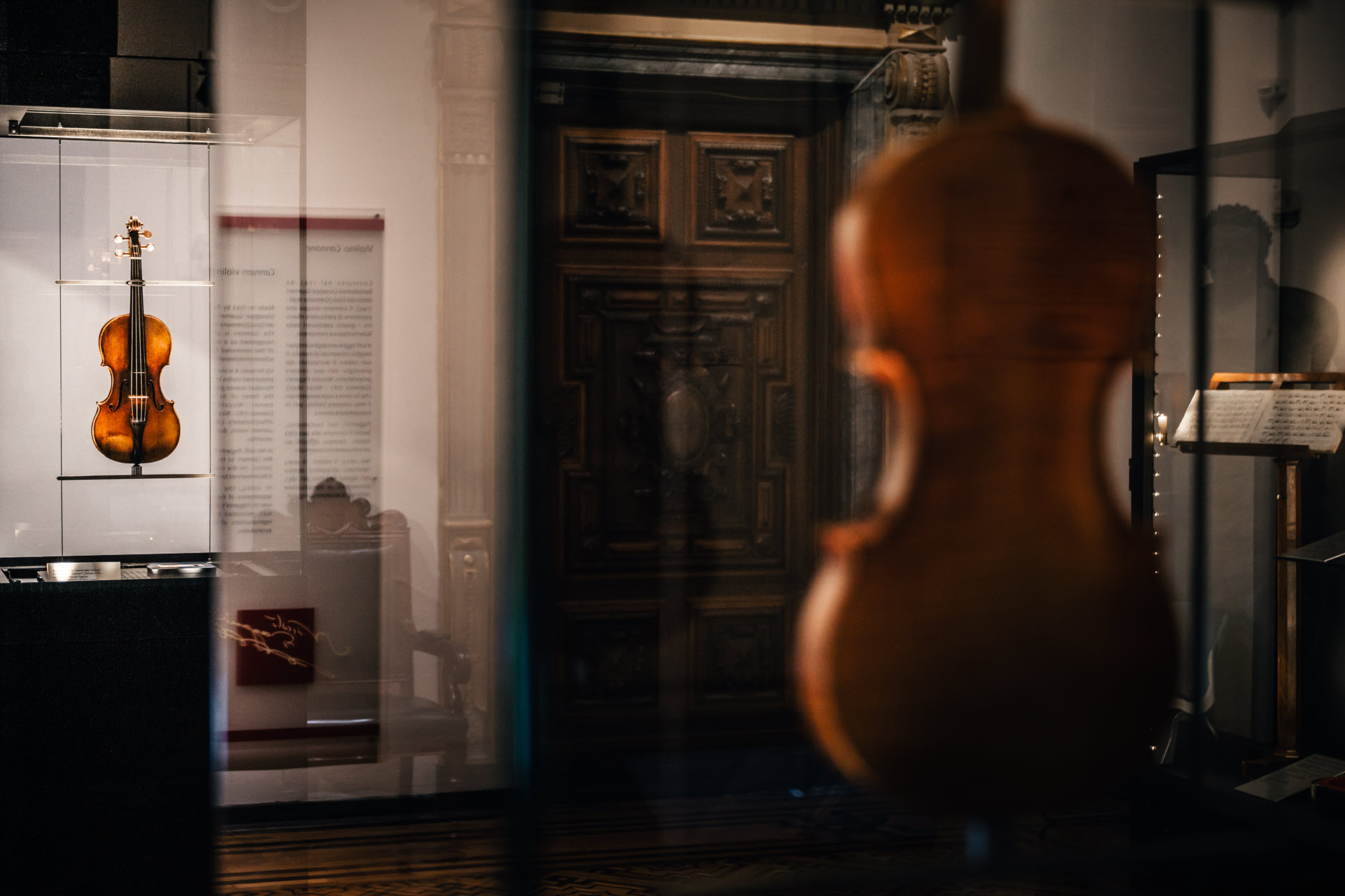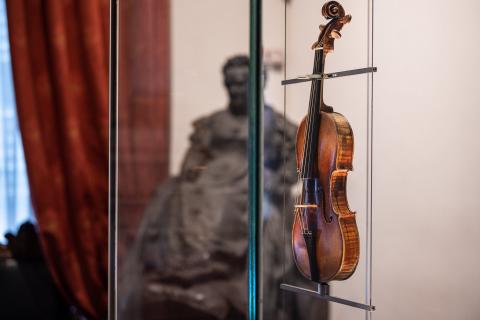Copies and models of the "Cannone" in Italy
by Alberto Giordano (Assistant violin-maker for the Maintenance of the Historical Violins)
Throughout the Italian peninsula in the first decades of the nineteenth century after the Napoleonic period there was general social disruption that also profoundly affected the world of violin making. There was in addition an increase in instrument production in neighbouring countries (exported at low prices to Italy) and a growing interest in instruments from the classical period which already formed an important part of the country's heritage.
As a result Italian craftsman turned to instrument repair rather than making. There was also a clear break from the classical tradition, bringing fundamental changes in style and methods of construction. However, one feature was carried through unchanged from the eighteenth century: the passion and enthusiasm for building new instruments without the use of artificial ageing, even though the models had classical inspiration sometimes interpreted with great freedom and ingenuity. It is said that this was also the result of Italy's isolation due to the complex political situation. The country was fragmented making travel and the exchange of ideas obviously very difficult.
Abroad the situation was very different. In France and England especially the market for old instruments grew steadily stronger and the demand for copy increased. These often made use of artificially aged wood and varnish, reproducing exactly the patterns of Amati, Stradivari and Guarneri. Production was particularly concentrated in specialist centres of manufacture like Mirecourt in France, Markeneukirchen in Germany etc.
In the case of Guarneri del Gesù, it was Niccolò Paganini who established his reputation at the beginning of the nineteenth century. Paganini's fame and exceptional musical abilities brought to wide notice a maker who hitherto had been given little consideration. When Paganini acquired the Cannon around 1802, Giuseppe Guarneri was considered a second choice, a maker from the years of decline in Cremonese work. Paganini was the first among musicians from the modern era to link his playing to a particular instrument, raising his reputation to mythic proportions.
During his lifetime Niccolò Paganini was somewhat protective of his instruments. The only maker who had a chance to make a copy with proper time and opportunity to study the original and, most important, with it on the bench besides him-was Jean-Baptiste Vuillaime. He undertook repairs to the violin in 1833. No Italian maker enjoyed this privilege. Some instruments by Ludovico Rastelli and Antonio Gibertini show signs of being influenced by the Cannon. It seems that they were only able to gather hasty evidence of the more obvious features-the 'f' holes for example-with no opportunity to consider the whole concept behind the Guarneri model; much like a street artist only able to make a quick charcoal sketch.
Of much greater interest is the work of Niccolò Bianchi, a Genoese maker working in Paris for some twenty years between 1848 and 1867. He was a skilled repairer and, more important, an excellent connoisseur of classical Italian making. Bianchi is probably the first Italian copyist in the modern sense, and perhaps the only one from the nineteenth century to dedicate himself to making copies using ageing techniques. The atmosphere in Paris had a strong influence on his working style and the high standards of his famous contemporaries deeply affected his style. As a man of the Risorgimento Bianchi was proud of his Italian roots and evolved a strong personal style, using skills and taste that set him apart from French colleagues(the 'Galli, as he mocking called them). One of his favourite models was a Guarneri del Gesù of 1741 (very similar in style to the Cannon) which was at the time the property of the Italian virtuoso, Antonio Bazzini. Bianchi seems to have grasped the unique skills of Guarneri's approach with its unpredictable fusion of controlled disorder. He had no particular interest in making exact copies, rigidly reproducing each detail. Rather he tried to capture the general 'feel' of the instrument, letting his personality find expression in the work. The instrument on show here, though based on an instrument other than the Cannon, nevertheless captures the latter's characteristics.
The maker who was most successful at combining creativity and accurate detail was Giuseppe Rocca. Abandoning the model used by his teacher Pressenda, he used two main models for his own violins: one from Stradivari based on the famous ' Messiah' of 1716, and one from a del Gesù instrument of 1742 which was later owned by Delphin Alard. Rocca was able not only to master the technical and stylistic fundamentals but also understood the method of construction of the instrument being copied, achieving a nice balance between proper respect for the original and his own sophisticated creativity. Supremely in his rendition of the 'Alard' he demonstrated this perfect fusion. The original has a rugged strength characteristic of late Guarneri work which is very challenging for the violin maker, whether he is attempting an exact copy or only using the original as a model. Rocca mostly used the originals as models for his own designs. In some cases, however, the varnish was lightly and delicately aged. It is worth remembering that Rocca, despite living for a total of thirteen years in Genoa, apparently never made a copy of the Cannon. Perhaps ha was not particularly impressed by it; or, more likely, he never had the chance to see it because of the strict condition of conservation in which it was kept.
A similar skill and refinement in interpreting del Gesù's work is evident in the output of Eugenio Praga, a Piemontese by birth and Genoese by adoption. Here again it is a matter of a model followed rather than exact copying. Praga had no interest in making antiqued instruments, despite nearly ten years of working under the guidance of his teacher, Nicolò Bianchi. To Praga we owe the first true rigorous interpretation of Paganini's Cannon. This was at the end of 1880s. The violin was very rarely played and presented few opportunities for close study. Very few had the chance of this. Perhaps because of his social position as the son of a prosperous family who had turned to violin making after graduating as an engineer, Praga was the first Italian maker to get to know an instrument closely and to be consulted about its care and conservation. By a slow but steady association with the instrument Praga was able to understand its precise characteristics and, having fully absorbed these, to make his own elegant and sophisticated reinterpretation. He is the only maker successfully to have used the head of the Cannon as the model for a new, non-antiqued, version. The scroll of the Praga violin presented here is, however, one that is still based on a model used by his teacher Bianchi.
A contemporary of Praga, who may have worked with him on occasion, was Enrico Rocca, Giuseppe'son. He dedicated himself to study of the Paganini violin, especially after Praga's death, since he was then able to get to know the instrument much more closely. His approach to violin making and to the Cannon in particular is less academic and cerebral. Here again we are talking of using it as a model rather than exact copying. Enrico Rocca's work is characterised by a freshness and natural grace which is transferred from the original to the new instrument. The delicate purfling, the clear varnish that shows the slight irregularities of the gouge cats beneath, the strong edge work, all combine as evidence of swift and confident work derived from the essential spirit of the Gesù's own working method. In contrast the head, in design recalling the work of Bianchi, shows the Rocca seeking his own personal solution, leaving aside the original model of the Cannon and achieving its own steady and skilful interpretation.
Cesare Candi, the foremost Genoese maker of the twentieth century, did not draw particular inspiration from the Cannon. The best known examples of the work are from the period 1915-18 when had reached his mature style. Although he shows the clear influence of Praga, Candi's characteristic approach makes his instruments unmistakable and made him very influential on the Genoese school in the first of the twentieth century. A fundamental characteristic is his method of construction, using and outside mould and lining that run across the corner blocks. His pupils followed this method faithfully, dedicating themselves to Paganini's violin as inspiration and making this the key feature of making in Genoa and the Ligurian region until after the Second World War. Others worthy of note are Candi's older brother Oreste, Giuseppe Lecchi (whose work is somewhat geometric in design), Lorenzo Bellafontana, who produced a very interesting copy of a Praga instrument ,and , above all, Paolo De Barbieri. He was the most talented and faithful pupil of Candi in deriving a model from the Canon, being particularly successful in the 1920s with accurate and elegant instruments whose body outline and design was carefully and sensitively rendered with slight softening at the corners. Except in rare cases he did not take the Cannon's scroll as a model, preferring to do something from his own hand inspired in its profile by the work of Nicolò Bianchi. It is worth while at this point to consider the importance of working methods in construction of the violin, since this is the fundamental creative force, the starting point for the whole process. At the end of the nineteenth century various different methods of construction were in use around Italy. This created a wide range of violin styles, an inheritance which provides us with a fascinating subject for study today: the sensitivity and enthusiasm in their varied interpretations, and sometimes the delightful discovery of their bold and ingenious freedom of expression.
In modern Italian violin making classical models are a starting point from which something distinctive and new is created. These are quite distinct from the historical instruments, almost as if the latter are a one-off product that remain essentially unique. It is also worth noting that the relationship with the past is constantly changing depending on the age we are considering. An earlier period has its own view history and this is very different from our own outlook today. Candi for example was closely tied to the outlook of his own day and sought to link violin making to the decorative 'Liberty' style, since he was convinced that violin making should be part of contemporary arts and crafts. In contrast we today have a passionate respect for the masters of the past which is almost overawed by their achievement, as if we considered them the product of a lost golden age which is already passed its peak. Copying their work is perhaps the only way of associating ourselves as is now possible with these great and beautiful works. The decision to undertake the copying of one of this instruments is an exacting and risky enterprise. The unique roughness of Guarneri's workmanship requires the highest technical and interpretative skill. For us makers the Canon represents instinctive creativity and free, expressive strength that seems almost violent and chaotic, all seen though our understanding of the great tradition. The Canon is the true test for the maker who does not want only to reproduce every single detail but also the patina of age the surrounds it. There are instruments that lend themselves perfectly to being copied in every detail, resulting in extremely fine modern copies. The current condition of the original instrument is an important factor in creating a copy since, for example, where varnish has been rubbed away the results in the modern copy will be more convincing since they derive from the original in its present condition. The difficulty is increased in the case of the Cannon since its enforced segregation that has now lasted a century and a half has preserved much more of its original condition. That stunning varnish on a velvety ground, that rough sculpting of the form, seem to look back at us with a mocking stare.
Excerpt from the catalogue "Originals Models and Copies" by the "Ente Triennale Internazionale degli Strumenti ad Arco" in Cremona, in collaboration with the "Consorzio Liutai & Archettai A. Stradivari" of Cremona.
The Catalogue was published on the occasion of the exhibit "Originals Models and Copies - The Cannone of Niccolò Paganini and musical still life: two cases compared", at the Museo Civico Ala Ponzone in Cremona from October 13 to October 21, 2001



